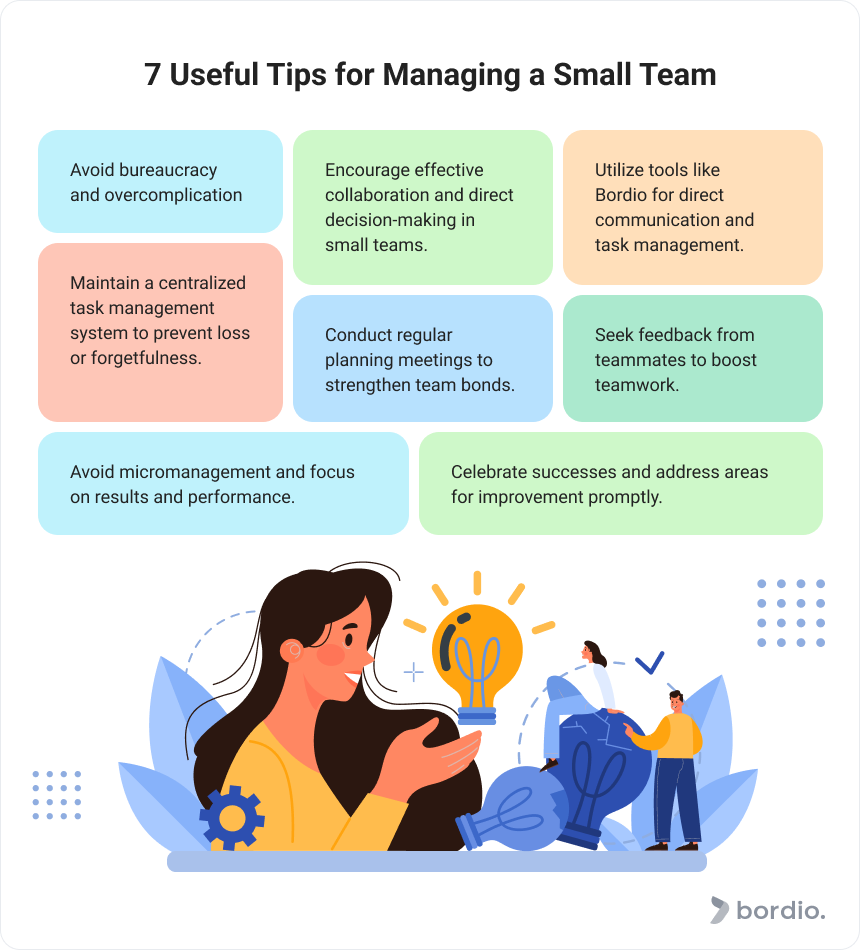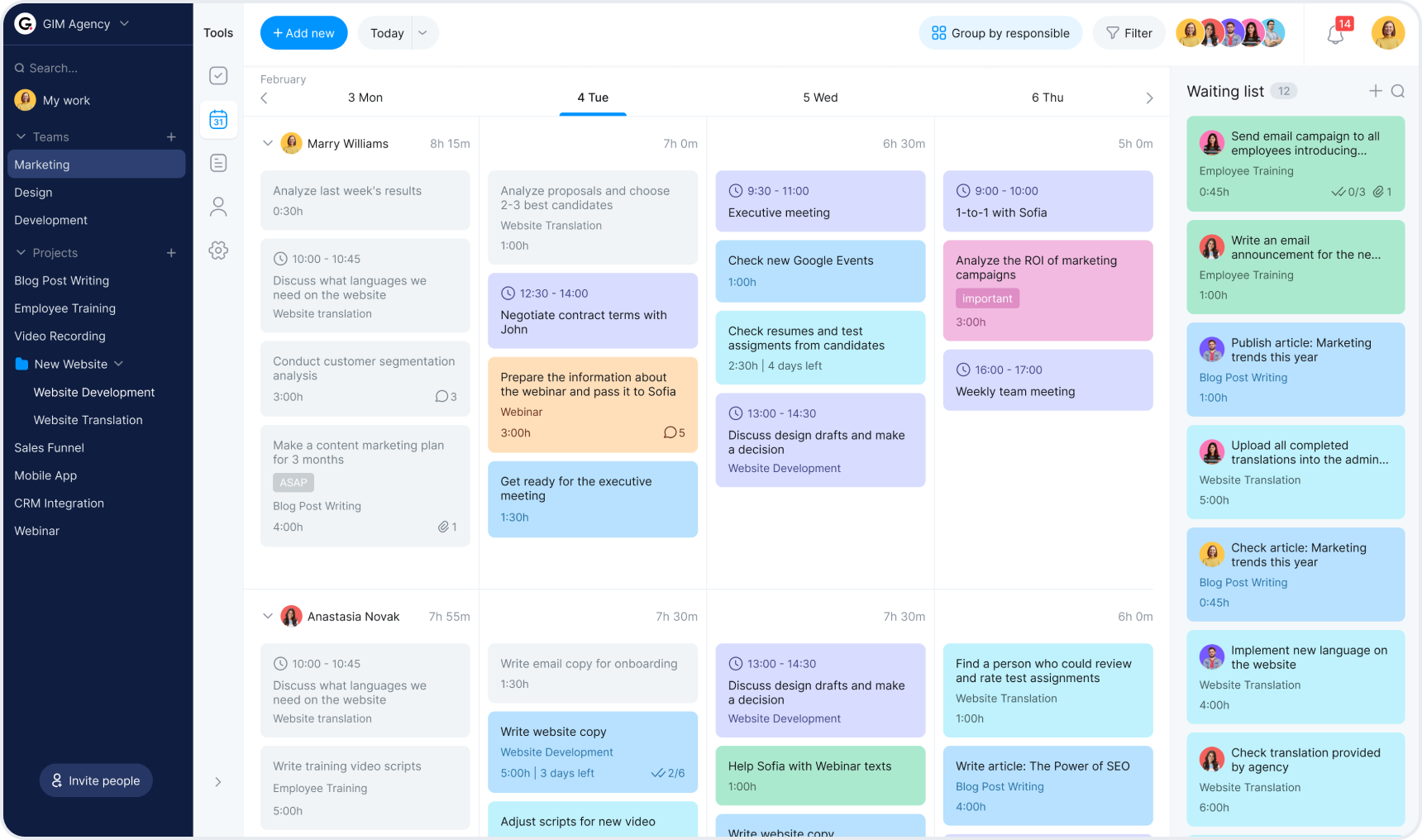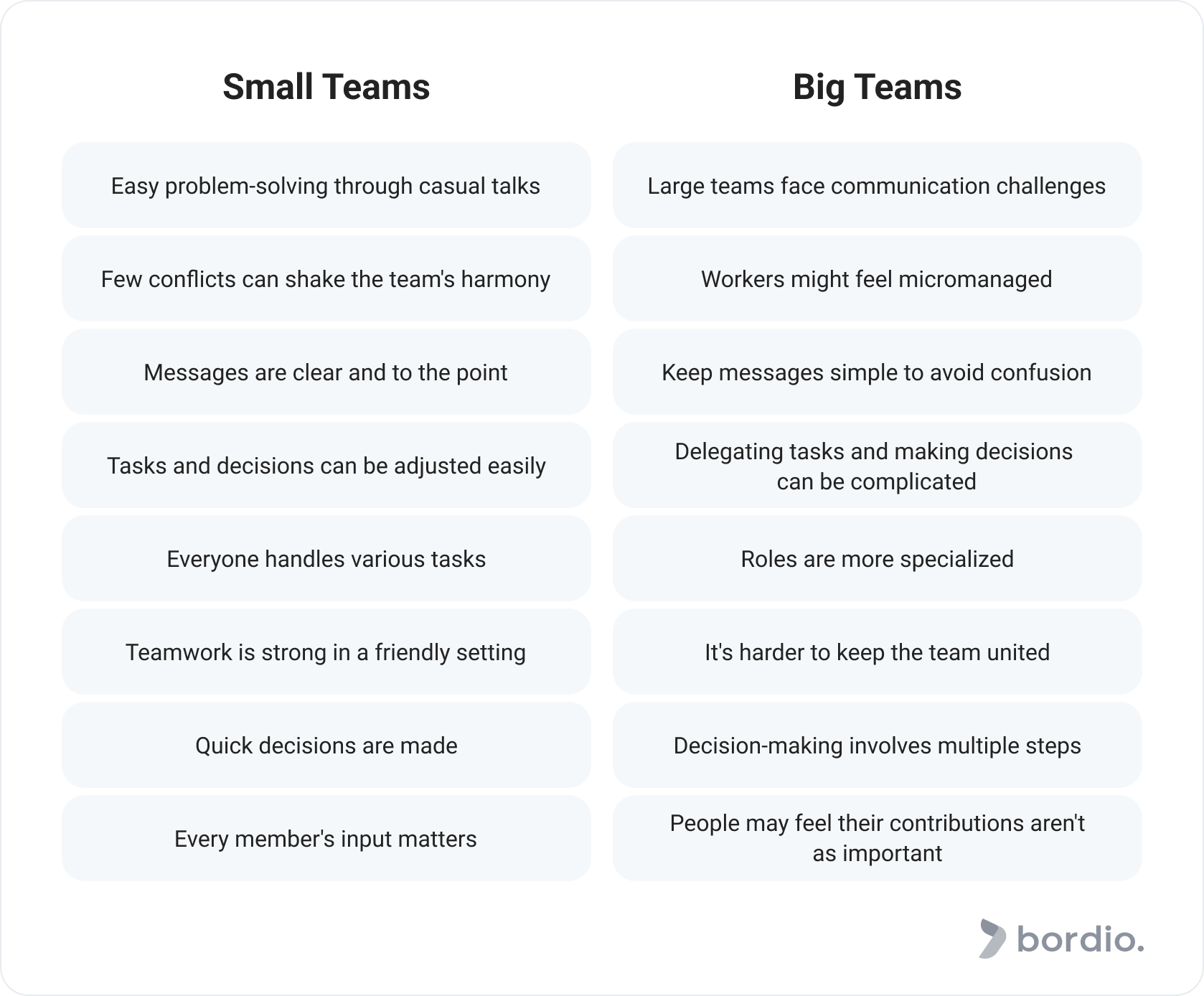Many people mistakenly believe that managing a small team will be much easier than a large one since fewer employees exist. However, let’s not underestimate small team management. Even though your team is more minor, you will still encounter some difficulties. For example, you can face a problem where there aren’t enough skilled people who can take over each other’s tasks, leading to everyone having too much work.
This article will examine the typical challenges managers of small teams and small businesses usually face. You’ll also find some advice on how to successfully manage a small team.
The challenges of managing small teams
Imagine you have opened a sizeable, cute café full of enthusiasm and assembled a small team of specialists. You are actively advertising and promoting your small business. As a team leader, you create a positive work environment, showing your leadership talent. But suddenly, you encounter unexpected problems.
For example, you lack the budget to hire additional staff to cover peak hours and ensure quality customer service. Then, one of the baristas fell sick, and no one could replace them without disrupting the café’s schedule and service quality. Additionally, another employee tends to engage in conflicts with colleagues due to differences in working methods. Team productivity is low, and a positive culture is ruined. So, how will you deal with the problems and create a successful team?
Challenge 1: Limited resources
Small teams often operate with limited resources, including workforce, budgets, and tools. This can lead to overwork and lousy team performance, as team members may need to take on multiple roles or responsibilities beyond their primary expertise.
Solution: Prioritize projects based on resource availability and deadlines. Consider outsourcing tasks to Virtual Accounting Support providers to manage workload efficiently and prevent employee burnout. We can say that automation and process optimization will greatly benefit you. Utilize tools and technologies to automate routine tasks and streamline workflows (it will be even more useful if you manage a remote team). For example, project management software like Bordio can assist in organizing workflow and task tracking. And don’t forget to invest in your personnel – train and enhance their skills; it will keep the team motivated and boost employee engagement.
Challenge 2: Increased workload
With fewer people to cover for absences, taking time off might be more difficult for team members without impacting project milestones or work quality.
Solution: Cross-train team members to enhance versatility and cover multiple roles. Invest in project management tools to help manage daily tasks and improve overall productivity and organization. Remember that work-life balance is important if you don’t want to lose employees and experience burnout. Promote open communication within the team so that members are not afraid to speak up about what they are dissatisfied with and to suggest their ideas with a clear vision. This way, you will create a positive culture and ensure that you and the team are on the same page.
Challenge 3: Diverse personalities of each team member
Each member’s contribution is critical in small teams. Relying too much on crucial people for specific jobs or expertise can be problematic if they’re out sick, on vacation, or quit.
Solution: Make it a priority to hire folks who help create a good team atmosphere and fit well with the company culture. Have regular feedback sessions and one-on-one chats to hear out team members, solve issues, and make plans more effectively. In small teams, everyone’s role is crucial. Depending too much on critical individuals for specific tasks or knowledge can become an issue if they’re unavailable due to sickness, taking a break, or leaving the company.
Challenge4: Limited perspectives
When your team is small, you run into the risk of having limited ideas and viewpoints. This can hold back creativity, new ideas, and solving problems because the team might miss out on different opinions that could help make better decisions.
Solution: Put into place ways to ensure you’re getting a wide range of ideas, like bringing together teams from different parts of the company or getting advice from outside experts or consultants. Make sure to have open discussions and brainstorming where everyone can share their ideas. Also, keep investing in training and learning chances to expand the skills and viewpoints of your team members. By building a work environment that values different views and people, you can tap into the combined smarts of your team to spark innovation and tackle problems.
7 Tips on how to manage a small team
And so, if we’ve addressed our challenges, it doesn’t mean it’s the end of the road! There’s always room for growth, and if the common challenges we’ve discussed no longer intimidate you, let’s now identify areas for further development. Let’s consider several helpful tips that will assist you in managing small teams more effectively.
Avoid bureaucracy; don’t overcomplicate things
In a small team of up to ten people, you can operate more effectively if you collaborate, talk to each other, and make decisions on the go. The key here is to talk less and do more. In large organizations, on the other hand, everything needs to be documented and aligned with the processes.
That’s why a simple bug fix or a straightforward feature can take several months in big corporations and a few days in a small team. Avoid implementing complex documentation processes in small teams, as this can reduce efficiency. Don’t take it wrong – you must establish some guidelines and processes in a small team so your teammates know where you manage tasks and to-do’s and have project files and notes. But don’t overcomplicate it.
Have direct communication with all your teammates
If your team is small (up to ten people), it’s better if they report directly to you. Don’t build multilevel management at this stage. Yes, you can attach some teammates as supervisors to juniors, but don’t isolate yourself from part of your team. Multilevel management is necessary for a bigger team (more than ten people).
Bordio facilitates direct communication with each team member. It’s a project management platform where your team members can track project progress, manage their schedules, and monitor workload. But that’s not all Borrio offers – it also allows you to comment on tasks and provide brief feedback. It features a chat function, similar to a messenger, to discuss work matters. Now, you don’t have to leave the platform to leave quick work-related comments.
Have a single place for all your tasks
When you are a small team, there is always a temptation to send a task to somebody directly through Slack or email. While it can work for some time, it will have negative consequences in the long run. Tasks may get lost or forgotten. So it’s essential to have a task management system from the first day of work and write down all tasks there. You still can send a message like “Hey, I’ve assigned a new task for you, here’s a link …” but it will be just a reminder/notification.
We suggest checking out Bordio as a task management system. With it, you can keep all your tasks in one spot. In Bordio team task planner, you can effortlessly create tasks without spending much time and then assign them to team members. Everything will be stored in one place, giving you access to work progress from both your phone and computer anytime, anywhere you are. Your calendar is also here to see your tasks and events together. Bordio is a handy tool that allows you to assign tasks to your employees and keep everything organized in one place without getting lost.
Regular planning meetings and review of work
When you’re part of a small team, it might seem like you don’t need to have meetings and can talk things through in chat. But this is a common mistake to avoid. Skipping regular team meetings and regular check-ins can harm how well you get along with your team members.
Team meetings set aside time for everyone to get together and discuss important stuff face-to-face. Direct communication helps strengthen bonds between team members. It creates a feeling of being united and working together, ensuring everyone understands what the team’s aiming for, when things need to be done, and what’s expected.
Also, team meetings are great for working through problems and making choices together. They let everyone on the team tackle issues as a group, develop ideas for solving them, and make intelligent decisions that are good for the whole team. Talking openly about how things are going, the problems you’re facing, and what you’ve achieved helps everyone keep each other in check regarding their duties and actions. This builds a work environment where people immensely trust and respect each other.
Ask your teammates for feedback
It’s essential to get your team involved in making decisions. Even if you have a small team, you can quickly shoot a message asking for their thoughts. You might say, “Hey everyone, we’ve got two designs here; which one do you think is better and why?” A simple message, but it unites the entire team. Your team members will feel that their opinions are equally important.
Bringing your team into the decision-making loop, even in a small group, is a smart move to boost teamwork and improve how well your team works together. When you use tools like messaging apps to ask for their input on the best design, you’re showing that you trust their judgment. This makes them feel valued and important. This method moves away from the old-school way where bosses make all the decisions towards a more open and equal way of working.
By getting everyone involved in making decisions, you’re pulling from a wide range of viewpoints, which helps build a culture where people respect each other and feel like they’re all together. Doing this leads to smarter decisions and creates a stronger sense of togetherness and dedication among the team. This, in turn, makes for a more driven and happy team overall.
Avoid micromanagement
It’s widespread for first-time managers who are managing small teams. They want to control everything – every little detail. They feel like no decision can be made without their approval. They track how long employees spend on tasks and how often team members get up from their desks daily.
While it’s part of a manager’s role to oversee the team, micromanaging can have harmful effects. Top employees might leave the company quickly due to a dislike for constant scrutiny. It’s similar to the difference between living in a free, democratic country and living in a totalitarian country, where the government controls everything you do.
To manage a small team without micromanaging, start by clearly explaining what you want the result of a task to look like. After that, give your team members the freedom to figure out how to get it done on their own. Concentrate on what you want achieved, not on how it gets done. Often, there are many ways to reach the desired outcome, so don’t restrict your team to one method you believe is best. Setting clear goals and providing a work task list helps keep them focused without the need for constant oversight.
Measure results and performance
Even though you shouldn’t micromanage every detail of your employees’ work, monitoring their results and their performance is essential. This ensures everyone is responsible for their work and gives you a clear picture of how individuals and the team perform. Set specific, clear goals for each team member that match the bigger company goals. After analyzing the work, you can input tasks into Bordio and assign them to team members. Then, on the team level, using a project tracking board, you can see who’s working on which task, as well as how much time was planned and time spent on tasks. This way, you can assess what was planned, what was accomplished, and how effectively team members are handling their responsibilities.
Track how everyone is moving towards these targets and offer helpful feedback on their performance. Celebrate their successes and quickly tackle any areas that need to get better. By keeping tabs on outcomes and how well everyone is doing, you can spot strengths and areas that need work, make wise choices on where to focus resources, and encourage ongoing progress in your team.
Positive sides of managing small teams
Enhanced Communication and Collaboration: Small teams foster a setting where straightforward and effective communication is the norm, minimizing misunderstandings and aligning everyone with project goals.
Boosted Engagement and Motivation: The close-knit nature of small teams creates a mentorship atmosphere where diverse skills and backgrounds enhance problem-solving and collaboration.
Increased Productivity and Innovation: With clearly defined roles, more accessible access to resources, and streamlined communication, small teams can manage work more efficiently, staying organized and on schedule.
Efficient Resource Management: Leaders find small teams more straightforward to manage due to simplified task assignments, progress monitoring, and addressing individual needs.
The differences between managing a small and large team
Big teams often do their own thing, like little self-run islands. They might see any advice or rules from above as nagging, which can make them unhappy. On the other hand, if just one or two folks in a small team start feeling out of sorts or butt heads, it can quickly mess up the team vibe.
Talking to a big group can be challenging. The key is to keep things simple, skipping over complex words that might confuse folks. You aim to share just enough information so everyone understands their tasks without overwhelming them with too much all at once.
With smaller teams, you can talk more casually and get to the heart of any issues, clearing up confusion quickly. No matter how big or small your team is, the main goal is to ensure your message is easy to understand, straight to the point, and exactly what your team needs to hear.
Final thoughts on managing small teams
Leading a small team comes with its own set of challenges and perks. Managing a few people might look more straightforward, but doing it well requires a deep understanding of how the team works together, communicates effectively, and uses resources wisely.
As discussed in this article, managing small teams well means finding the right balance between letting people work independently and offering the guidance and support they need. By having open conversations, asking for input, and building a workplace where people are accountable and trust each other, leaders can make team members feel important, driven, and ready to reach their goals. By facing the challenges and making the most of the advantages of leading small teams, leaders can foster a work culture that focuses on excellence, bouncing back from setbacks, and continually improving, setting the stage for lasting success and development.








